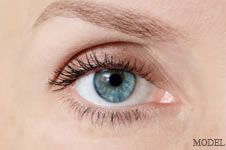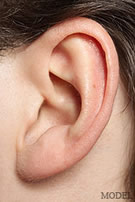
 Eyelid surgery, also called an eyelid lift or blepharoplasty, can rejuvenate puffy, sagging or tired-looking eyes by removing excess fat, skin and muscle from the upper and/or lower eyelids. Eyelid surgery may be performed for cosmetic reasons or to improve sight by lifting droopy eyelids out of the patient's field of vision.
Eyelid surgery, also called an eyelid lift or blepharoplasty, can rejuvenate puffy, sagging or tired-looking eyes by removing excess fat, skin and muscle from the upper and/or lower eyelids. Eyelid surgery may be performed for cosmetic reasons or to improve sight by lifting droopy eyelids out of the patient's field of vision.
What can eyelid surgery do for me?
Blepharoplasty is ideal for the correction of:
The Procedure
Eyelid surgery is usually performed in an office, usually with local anesthesia and IV sedation. The procedure can take less than 45 minutes for upper eyelids but is more involved for lower eyelid rejuvenation.
Incisions are made along the eyelids in inconspicuous places: in the natural creases of the upper lids for upper eyelid blepharoplasty and just below the lash line on the lower lids for lower eyelid blepharoplasty. If no skin needs to be removed, the surgeon will likely perform a transconjunctival blepharoplasty, where the incision is made inside the lower eyelid and there are no visible scars.
In all cases, the surgeon then removes excess skin from the eyelids using a scalpel. Fat may be removed or re-draped. The surgeon then closes the incisions with fine sutures.
 Otoplasty, or ear surgery, is a surgical procedure performed to correct large, protruding or otherwise deformed ears for a more proportionate appearance. Unlike most other plastic surgery procedures, otoplasty is most commonly performed on children, as the ears achieve most of their growth by age 5. Early treatment helps reduce teasing and any affect on self-esteem that large or misshapen ears may cause. Otoplasty may often be performed to correct ears damaged by an accident or injury.
Otoplasty, or ear surgery, is a surgical procedure performed to correct large, protruding or otherwise deformed ears for a more proportionate appearance. Unlike most other plastic surgery procedures, otoplasty is most commonly performed on children, as the ears achieve most of their growth by age 5. Early treatment helps reduce teasing and any affect on self-esteem that large or misshapen ears may cause. Otoplasty may often be performed to correct ears damaged by an accident or injury.
During the otoplasty procedure, an incision is made behind the ear to remove or reshape the cartilage and adjust the size and position of the ears for a more natural-looking appearance. For children, this procedure is usually performed under general anesthesia, while adults usually only require local anesthesia and sedation. Both ears may be operated on in order to achieve better balance. The results of the otoplasty procedure are permanent and scars will fade with time to become less noticeable.
Also known as a forehead lift, a brow lift is a surgical procedure performed to reduce signs of aging on the eyebrows and/or forehead. It may also treat certain hereditary facial features. A brow lift is commonly performed in conjunction with other procedures, such as a facelift, to provide a balanced, youthful appearance to the face.
Candidates for brow lift surgery typically have deep horizontal creases across their forehead, frown lines between their eyebrows or across their nose, and/or sagging eyebrows, leaving them with a tired or sad appearance. Individuals seeking a brow lift often feel that they do not look as young as they feel.
Common Brow Lift Techniques
Traditionally, brow lift surgery involved a large incision across the top of the forehead. Advancements in technology have led to the endoscopic technique, in which three to five small incisions are made across the forehead behind the hairline. These shorter incisions allow for a shorter recovery time when compared to the traditional brow lift technique. During your consultation, your plastic surgeon will explain the exact approach he or she will use for your brow lift procedure.
 Lip augmentation increases the size of the lip for patients whose lips have lost volume with age, or who are unhappy with the natural appearance of their lips. Through injectable fillers, autologous grafts or synthetic implants, patients can achieve larger, fuller lips with minimal downtime and little to no side effects. With realistic expectations and good overall health, most patients are satisfied with the results of this procedure.
Lip augmentation increases the size of the lip for patients whose lips have lost volume with age, or who are unhappy with the natural appearance of their lips. Through injectable fillers, autologous grafts or synthetic implants, patients can achieve larger, fuller lips with minimal downtime and little to no side effects. With realistic expectations and good overall health, most patients are satisfied with the results of this procedure.
This procedure is performed on an outpatient basis and requires only a local anesthetic. If incisions are needed, they are often made in the mouth to conceal any scarring. Injectable fillers produce fuller lips that last for several months, while implants can provide permanent enhancement.
Patients will likely experience mild swelling and discomfort after lip augmentation, but these symptoms usually go away on their own within a few days, at which point patients can enjoy fuller lips and an overall enhanced appearance.
Chin implants reduce the chin to help provide a harmonious balance to the facial features, improving the facial profile and augmenting a weak chin. By placing a biocompatible implant in the lower jaw, patients can create a stronger chin and even lengthen the entire face. While many patients used dermal fillers to increase the size of their chin, these results only last for a few months and require frequent touch ups. In comparison, chin implants offer patients permanent results that can be customized to achieve your unique desired look.
This procedure is commonly recommended in conjunction with rhinoplasty in order to achieve a more satisfying facial proportion, since the size of the chin may be affected by the new size and shape of the nose. It may also be combined with cheek implants or a lip augmentation for maximum aesthetic results. Many patients do not come to a plastic surgeon requesting a chin implant, but are usually pleased with the outcome of this procedure after their doctor suggested it.
Over time, a pierced earlobe can become stretched if a person frequently wears large or heavy earrings. In addition to creating a long or wide opening, earrings may tear completely through the lobe. A torn earlobe may also result from trauma, such as having an earring pulled off or caught on clothing.
Torn earlobes can be repaired with a quick in-office procedure performed under local anesthesia.
Torn earlobe repair first involves "freshening" the edges of the torn lobe by removing a small amount of skin. Then, using fine sutures, the earlobe is meticulously repaired to reconstruct a normal, rounded earlobe that matches your natural ear shape.
You will be able to return home immediately after the procedure, with only a small bandage covering the stitches. The stitches will be removed after one to two weeks. When the earlobe has healed and the scar has softened, you may re-pierce the repaired earlobe. It takes about three months for the earlobe to fully heal.
Laser skin resurfacing, commonly called a laser peel, removes the outer, damaged layer of skin to reveal a smoother, younger look. Laser resurfacing can reduce the appearance of sun damage, wrinkles, fine lines, uneven pigmentation and superficial scarring, usually on the face. A carbon dioxide (CO2) laser beam of precisely focused light vaporizes the surface skin and reveals the undamaged layer beneath. Procedure time varies depending on the size and condition of the area being treated.
To learn more about the Face Procedures we provide, please call us today to schedule a consultation.